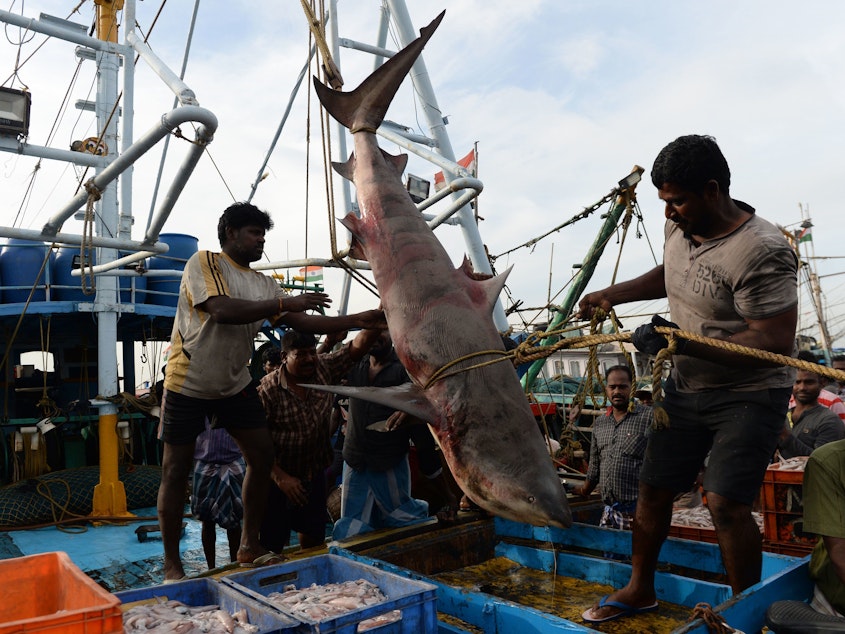Sharks Have Few Places To Hide From Fishing, Study Shows

Ocean-dwelling sharks often like to hang out in areas that also get frequented by industrial fishing ships, which puts them at grave risk of being caught either for food or as bycatch.
That's according to a new study in the journal Nature that mapped the activity of 23 shark species and fishing vessels around the globe.
Researchers tracked more than 1,500 sharks with satellite tags and combined that data with information on ship movements taken from safety technology that vessels use to avoid collisions at sea.
"Tens of millions of these pelagic sharks are being caught by industrialized fisheries in areas where there's little or no management, and some populations have declined as a result," says David Sims, a U.K.-based marine ecologist at the Marine Biological Association in Plymouth and the University of Southampton.
Fishing vessels can catch sharks accidentally, because their long lines can extend for miles and have more than 1,000 hooks.
Sponsored
And in recent decades, sharks are targeted deliberately because the value of the meat, especially the fins used for shark fin soup, has gone up. "There's a real demand for shark products, and that has driven the fishery," Sims says.
Sharks are known to be incredible travelers, undertaking huge journeys across the ocean. But researchers didn't have a sense of the sharks' favorite haunts, where they might be most vulnerable to pressure from industrial fishing.
"We wanted to really take this big-scale, sort of global view of where sharks were hanging out," Sims says. "Over the last three years, we've built this international team of over 150 shark scientists who have all worked together and collaborated to pool their data into a giant database."
In that database are satellite tracks from large species like white sharks and whale sharks and shortfin mako sharks. "If you have enough individuals in the database, you can start to piece together where they prefer to be in the ocean," Sims says.
What they found is that sharks generally like to swim along the boundaries of different types of water masses — like a spot in the North Atlantic where the warm waters of the Gulf Stream converge with colder water in the Labrador Current.
Sponsored
The research team then turned to data from an organization called Global Fishing Watch, which has information on tens of thousands of vessels that use anticollision technology called the automatic identification system, which lets ships basically broadcast their location, course and speed.
Overall, around 24% of the space used by sharks in an average month overlapped with long-line fisheries.
"But if we look at those species which actually are most at risk, we see that the overlap values are much, much higher," Sims says.
For blue sharks in the North Atlantic, 76% of the space used in an average month was overlapped by long-line fishing. For North Atlantic shortfin mako sharks, it was 62%.
"Unfortunately, what we found in this study is there were very few large-scale hotspots of sharks that weren't overlapped at some time of the year by long-line fishing," Sims says.
Sponsored
That means the sharks don't have many safe refuges, says Sims, who notes that currently, "fishing for sharks on the high seas generally has little or no management for the majority of species."
What's exciting about this study is the way it describes not just the overlaps between shark habitat and industrial fishing, but also how these overlaps change over the course of the year, says Elliott Hazen, a research ecologist with NOAA's Southwest Fisheries Science Center in Monterey, Calif.
"It really creates an opportunity for finer scale management than we're usually able to do," Hazen says. "And so I really hope that the results from this paper are able to inform whether it's time-area closures or more dynamic management tools that can allow us to fish for the species that we want to catch and avoid the shark species that are often making our seafood choices unsustainable."
He notes that a lot of the overlaps in this study are actually happening in the high seas, which have no country jurisdiction. He sees that as both a potential opportunity and a potential difficulty for conservation efforts.
And whenever you get into the management of highly migratory species, he notes, there's going to be a tradeoff where decision-makers will have to decide what's more important: conservation efforts, or the economic benefits of the fishing opportunity.
Sponsored
Still, Hazen says, this study is "a great example of how you can kind of put technology, and even the newest technology, to bear to get the answers that are needed by management conservation."
He'd love to see a study done like this for tuna. "A lot of tuna are, you know, some of the most valuable fisheries globally. And there is a lot of debate as to how much is caught in the world's oceans," Hazen says. [Copyright 2019 NPR]



